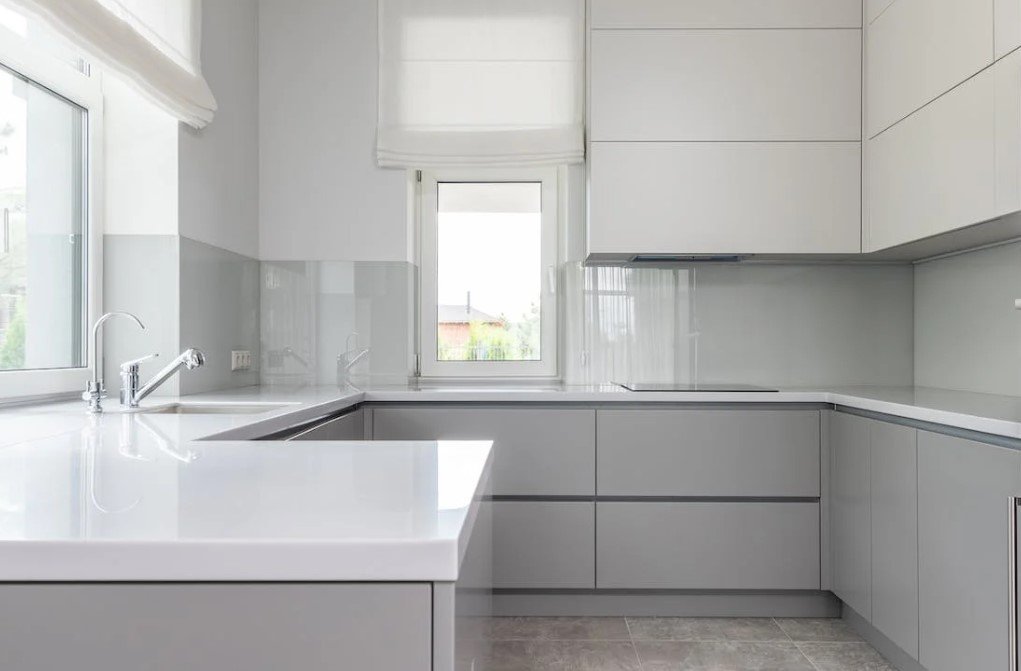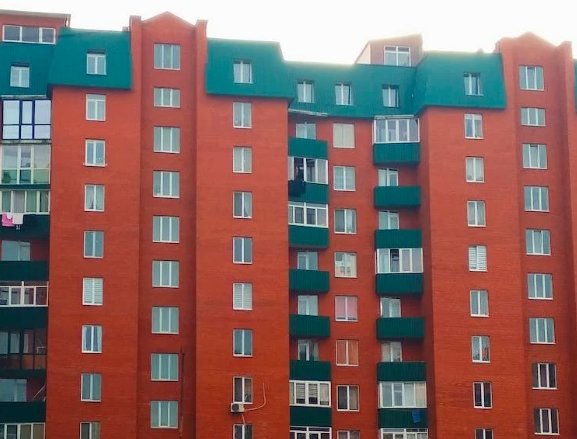Are you tired of walking into the same old kitchen every day? Maybe you’re ready for a change but don’t want to spend a fortune on a full remodel. Look no further! A fresh coat of paint can transform your kitchen into a whole new space without breaking the bank.
The kitchen is often the heart of the home, where family and friends gather to cook and eat together. It’s important to have a welcoming and functional area that inspires creativity and enjoyment. A kitchen renovation can improve the value of your home and make meal preparation easier and more enjoyable. However, not everyone has the budget for a full renovation. That’s why painting your kitchen cabinets, walls, and even appliances can make a huge impact on your kitchen’s look and feel.

In this article, we will guide you through the process of painting your kitchen, no matter your skill level. We’ll cover everything from choosing the right paint color to preparing the surfaces and applying the paint. Follow these easy steps and you’ll have a kitchen that looks like it belongs in a magazine in no time!
Assessing the Kitchen Space
A. Evaluating the Existing Layout and Design:
When looking to update your kitchen with a fresh coat of paint, it’s important to thoroughly evaluate the current layout and design of your kitchen. This includes considering the size and shape of the room, the placement of appliances, and the flow of traffic. Take measurements of the space and create a floor plan to help visualize potential changes and solutions for your kitchen.
B. Identifying Problem Areas and Pain Points:
In order to create a functional and efficient kitchen, it’s important to identify any problem areas or pain points in your current layout. Common issues may include a lack of counter space, poor lighting, or outdated appliances. Take note of what isn’t working in your current kitchen and consider how you can address these issues during the painting process.
C. Creating a Workable Solution:
Based on your evaluation of the existing layout and design, as well as the identified problem areas, it’s time to create a workable solution for your kitchen. This may involve reorganizing the placement of appliances, installing additional counter space, or updating lighting fixtures. As you plan for the painting process, consider how these changes will impact the final aesthetic and ensure that they will fit within your budget.
Choosing the Color Scheme
A. Importance of Color in Interior Design
Color is one of the most important aspects of interior design. It is the easiest way to create a mood and atmosphere in any room. The color we choose for our kitchen has an impact on everything from our appetite to our mood. Some colors make us feel energized and lively, while others can create a calm and inviting space. For example, red and orange shades can make us feel hungry, while blue and green shades create a more relaxing and calming environment. Therefore, choosing the right color scheme is crucial when designing a kitchen.
B. Coordinating Color Palette for the Kitchen
When it comes to choosing a color scheme for the kitchen, the first thing to consider is the existing color of the countertops, floors, and appliances. The color palette should complement these elements rather than clash with them. One of the best ways to coordinate a color palette is to choose a dominant color and then use complementary colors around it to create contrast and depth. For example, a white kitchen can be paired with shades of blue, green, or gray to add a pop of color.
In addition, it is important to consider the size of the kitchen when choosing a color scheme. Light colors make a small kitchen appear bigger, while darker colors make a larger kitchen feel smaller. Therefore, if the kitchen is small, it is best to choose light colors such as white or light pastels to create the illusion of space.
C. Balancing Textures and Patterns
One of the challenges of designing a kitchen is balancing different textures and patterns. Too much of any one texture or pattern can create a dull and lifeless environment. It is important to mix and match different textures and patterns to create visual interest and depth in the space. For example, a marble countertop can be paired with a backsplash made of tiles with a different finish. A wooden table can be paired with metal bar stools to create contrast.
Upgrading Cabinets, Countertops, and Appliances
A. Modernizing cabinets with a fresh coat of paint or hardware
Upgrading the cabinets in your kitchen is a great way to give the room a new look and feel without having to do a full-scale renovation. A cost-effective way to modernize cabinets is to give them a fresh coat of paint. You can select a bold color to make them pop or a neutral color to give them a classic look. If you want to go a step further, you can replace the cabinet hardware to complement the new paint job. This can include replacing handles, knobs, and pulls to match the new color scheme and give the cabinets a more contemporary feel.
B. Replacing countertops to boost functionality
Countertops are one of the most important elements of a kitchen. They are where you prepare meals, place appliances, and perform other tasks. Replacing old countertops with new ones can make a big difference in not only the functionality and aesthetics of the kitchen but also its value. The type of material to choose will depend on your budget, style preferences, and how much use the countertop will get. Basic options include laminate, which is low-cost and easy to maintain, while natural stone such as granite or marble can bring a sense of luxury to the kitchen.
C. Upgrading kitchen appliances to enhance user experience
Kitchen appliances are at the forefront of functionality in any kitchen. Updating these can bring a refreshing look to the room. New appliances can also make your kitchen more energy-efficient, save money on energy bills, and provide a better user experience. When selecting new appliances, consider the size, capacity, brand, and color to match the new style of your kitchen. Commonly updated appliances include refrigerators, ovens, cooktops, and range hoods. It’s essential to take accurate measurements before purchasing any new appliance to ensure it fits correctly.
Enhancing Lighting and Flooring:
A. Incorporating Natural Light
Natural light is essential in any kitchen as it helps to provide a bright and warm atmosphere. You can incorporate natural light into your kitchen design by installing larger windows, skylights, or French doors that open up to let in more light. You can also add an airy feel to the kitchen by using lighter shades of paint color and choosing lighter furniture finishes, such as white or light wood.
B. Choosing Durable Flooring Materials
The kitchen is one area of the home that experiences heavy foot traffic and wear and tear from spills and stains. Choosing a durable flooring material, such as porcelain tile, wood, or vinyl is important. Porcelain tile is an excellent option for durability and comes in a variety of textures and colors. Wood flooring is also popular for its natural beauty and durability, but it requires regular polishing and upkeep. Vinyl is a budget-friendly and low-maintenance option that mimics the look of wood or tile.
C. Upgrading Lighting Fixtures for Functional and Aesthetic Appeal
Lighting fixtures are the perfect way to enhance the look and functionality of your kitchen. One popular choice is pendant lighting. They come in a range of styles, colors, and finishes, and can be hung over the kitchen island or dining table for a dramatic look. Track lighting is also popular and allows you to adjust the direction of the lighting to fit your task. Adding under-cabinet lighting also brightens up your counter and workspaces.
Backsplash Ideas:
A. Transforming the Backsplash with a Fresh Coat of Paint or Tiles
A fresh coat of paint or new tiles can transform your kitchen backsplash. Painting the backsplash is an affordable and easy way to create a bold statement without doing a full renovation. You can choose a color that complements your kitchen’s color scheme or opt for a bold contrast for visual interest. Tiles, on the other hand, come in a variety of shapes and colors that can add texture and pattern to your backsplash.
B. Coordinating Backsplash with the Color Scheme
Your backsplash should coordinate with your kitchen’s color scheme. You can choose tiles or paint that match your cabinets or countertops to create a cohesive look. A neutral or monochromatic color scheme can also create a clean and sophisticated look.
C. Adding Visual Interest with Patterns or Textures
Patterns and textures can add interest and dimension to your kitchen’s backsplash. Subway tiles are a classic option that comes in a variety of colors and textures. Bold geometric patterns or intricate mosaics are also popular choices that can elevate the look of your backsplash.
Maximizing Storage and Improving Workflow
A. Utilizing space effectively:
When renovating a kitchen, it’s essential to make the most of every inch of space available. This means utilizing corner cabinets, installing pull-out shelves and drawers, and adding storage solutions like pantry organizers, hanging racks, and cabinet door organizers. Utilizing space effectively will ensure that everything has its place, which will make the kitchen appear more organized and spacious.
B. Maximizing storage options with smart organizing solutions:
A well-organized kitchen is not only aesthetically pleasing, but it also contributes to better workflow and reduces clutter. Maximizing storage options with smart organizing solutions like pegboards, magnetic knife strips, and built-in wine racks can significantly improve the functionality of the kitchen. It’s important to identify what items you need to store, how often you use them, and where you use them to create a storage plan that works for you.
C. Improving workflow in the kitchen for a more efficient space:
Workflow refers to the way food and supplies move from storage and preparation areas to cooking and serving spaces. Improving workflow in the kitchen can make meal preparation smoother and more efficient. It’s important to consider the kitchen’s layout, including the placement of appliances, countertops, and storage options, to create a functional space that optimizes workflow.
Personalizing the Kitchen Space
A. Tailoring to personal style:
The kitchen is one of the most used areas in the home and should reflect the personal style and taste of the owner. When designing a kitchen, it’s important to choose colors, textures, and materials that complement your personal style. These choices can include cabinet finishes, countertops, lighting fixtures, and backsplashes, among others.
B. Adding unique touches through décor and accessories:
Decor and accessories can add unique touches to the kitchen space and make it less utilitarian. This can include hardware, wall art, dishware, and kitchen utensils. Personalizing the space with decorative elements can enhance the atmosphere of the kitchen and create an inviting and cozy environment.
C. Choosing design elements that create a welcoming environment:
A welcoming kitchen can make guests feel at ease and create a comfortable space for home residents. This can be achieved by choosing design elements that include warm lighting, comfortable seating, and inviting textures and finishes. Personal touches like fresh flowers or a bowl of fruit on the countertop can also contribute to a warm and welcoming atmosphere.
D. Adding value to your home with kitchen renovation:
The kitchen is one of the most important rooms in the home, and a renovation can significantly increase the value of a property. A well-designed and functional kitchen can be a significant factor in potential buyers’ decision-making process, making it an excellent investment in a property.
Conclusion
A kitchen renovation can bring about a multitude of benefits for homeowners. From improving the functionality and increasing storage space to enhancing the aesthetic appeal and adding value to the home, a fresh coat of paint is just one aspect of a kitchen renovation that can make a significant impact. Not only does it provide a cost-effective way to update the space, but it also allows homeowners to express their personal style and create a welcoming atmosphere for family and friends.
Transforming your kitchen space may seem like a daunting task, but with careful planning and execution, it can be a fun and rewarding experience. By taking into consideration your budget, style preferences, and practical needs, you can create a space that reflects your personality and meets your daily requirements. Remember, a kitchen is more than just a functional space; it’s the heart of your home, and with a little creativity and effort, you can cook up a storm while enjoying the beauty and comfort of your revamped kitchen.
FAQs – Kitchen Renovation
1. What are the benefits of repainting my kitchen?
Answer: Repainting your kitchen can give it a fresh look, improve its overall aesthetic, and increase its value. It can also help protect the surfaces from damage and make them easier to clean.
2. What type of paint is best for my kitchen?
Answer: It is best to use a paint specifically formulated for kitchens, such as one that is moisture-resistant and easy to clean.
3. Do I need to prepare my kitchen before painting it?
Answer: Yes, you should thoroughly clean all surfaces, remove any dirt, grease and dust, and cover or remove any appliances, fixtures or furniture that you don’t want to get paint on.
4. Can I paint over the existing wallpaper in my kitchen?
Answer: It is usually not recommended to paint over existing wallpaper as it can create problems with adhesion, causing the paint to peel or flake off over time. It is best to remove the wallpaper before painting.
5. How many coats of paint do I need for my kitchen?
Answer: It is usually best to apply two coats of paint to achieve the best coverage and durability.
6. Can I paint my kitchen cabinets?
Answer: Yes, it is possible to paint kitchen cabinets, but it requires proper preparation and techniques to ensure a lasting and professional-looking finish.
7. Does the color of the paint matter for my kitchen?
Answer: The color of the paint can have an impact on the mood and atmosphere of your kitchen. Lighter tones can make the space look brighter and more open, while darker colors can create a dramatic or cozy feel.
8. Can I paint my kitchen by myself, or do I need a professional painter?
Answer: You can definitely paint your kitchen by yourself if you have the time, patience, and skill. However, hiring a professional painter can ensure a high-quality, long-lasting finish and save you time and effort.
9. How long will it take to paint my kitchen?
Answer: The amount of time it takes to paint a kitchen depends on its size, the condition of the surfaces, and the number of coats required. On average, it can take anywhere from a few days to a few weeks.
10. How can I maintain my freshly painted kitchen?
Answer: You should avoid exposing the surfaces to excessive moisture or high heat, and use only gentle cleaning products and tools. Regular cleaning and touch-ups can also help maintain the appearance of your freshly painted kitchen.














